What is a Premature Birth?
How to prevent it and how to respond to it when it occurs
(including newborn care and complications)
Premature birth or preterm birth is said to occur when a baby is born before the completion of 37 weeks of pregnancy. The final weeks of pregnancy are vital for the full development of the baby’s lungs, brain, and liver. Babies born prematurely (especially before 32 weeks gestation) are at higher risk of birth injury including hypoxic-ischemic encephalopathy (HIE) and cerebral palsy.

Low birth weight and preterm birth account for about 17% of infant deaths within the first 12 months after birth. Common complications premature babies may experience include developmental delays, cerebral palsy, breathing problems, and vision or hearing problems—but many of these complications are avoidable. According to the CDC figures, premature birth affects about one out of 10 babies born in the United States.
Medical providers generally use the following terms to describe a premature birth:
- Late preterm: Birth of a baby between 34 and 36 weeks of pregnancy
- Moderately preterm: Birth of a baby between 32 and 34 weeks of pregnancy
- Very preterm: Birth of a baby before the completion of 32 weeks of pregnancy
- Extremely preterm: Birth of a baby before the completion of 25 weeks of pregnancy
Premature Babies Need Special Care
The earlier a preterm birth occurs, the greater is the likelihood of health problems for the baby. While all babies born before the completion of 37 weeks of pregnancy are at a risk of health problems, the likelihood significantly increases when the preterm birth occurs before 34 weeks gestation.
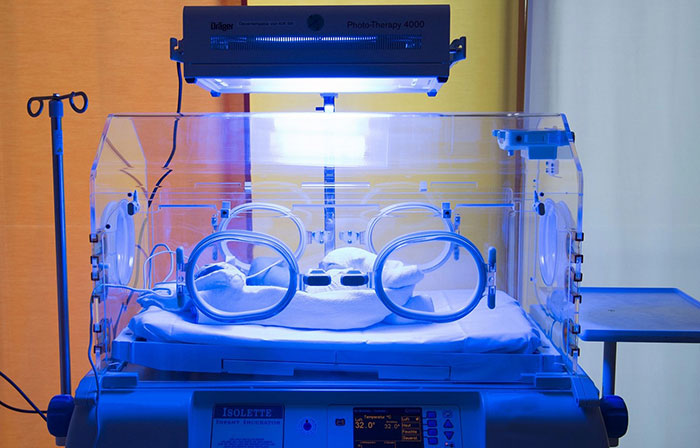
A preterm baby may have to spend time in the NICU (newborn intensive care unit) at a hospital until their vital organs are sufficiently developed to sustain without medical support. NICU care may sometimes be necessary for weeks or months until the baby is:
- (a) ready to breathe without support
- (b) can accept breastfeed or bottle-feed
- (c) has a stable body temperature
- (d) is steadily gaining weight
Even when a premature baby leaves the hospital, they may require medications, special medical equipment, or other medical treatments and support. The medical provider at the hospital may recommend regular checkups from a neonatologist to monitor the baby’s progress.
Health Risks in Premature Babies
Breathing Problems
- Respiratory Distress Syndrome (RDS): In this condition, the baby’s lungs are unable to produce an adequate amount of surfactant (a substance that prevents the collapse of the tiny air sacs in the baby’s lungs.)
- Bronchopulmonary Dysplasia (BPD): Preterm babies can develop this condition, which puts them at an increased risk of contracting lung infections or other types of lung damage.
- Apnea of Prematurity (AOP): This complication in premature babies is said to occur when they experience intermitted pauses in breathing for at least 15 to 20 seconds. AOP may be accompanied by fetal bradycardia or slow heart rate.
Medical Errors and Prevention Strategies
According to researchersimplementation of neonatal resuscitation measures can reduce the chances of a brain injury from hypoxia or anoxia. Failure to recognize the symptoms and promptly initiate management strategies to address the cause of respiratory distress in babies can result in serious complications. These may include respiratory failure leading to hypoxic-ischemic encephalopathy and cerebral palsy.
The underlying cause of breathing problems in premature babies may not always exist within the lungs alone. After initial neonatal resuscitation and stabilization, the medical providers must evaluate the detailed medical history, conduct a physical examination, and review laboratory and radiographic findings to make a more specific or differential diagnosis and adjust the treatment appropriately.
If the baby shows signs of HIE and meets the criteria, hypothermia treatment should be initiated to slow and/or prevent continuing brain injury.
Intraventricular Hemorrhage (IVH)
IVH is described as a condition when bleeding occurs in the ventricles (fluid-filled spaces) in the baby’s brain. The earlier the preterm birth occurs, the higher is the risk of IVH for the baby. IVH is a major risk factor for cerebral palsy and is seen more commonly in extremely premature babies that have experienced lung collapse, respiratory distress syndrome, or gestational hypertension.

IVH most often occurs within the first 48 hours after birth. Hypoxic-ischemic encephalopathy (HIE) is a serious potential contributing factor to this condition, which can lead to cerebral palsy. Therapeutic hypothermia for preterm babies with a gestational age of 36 weeks or more is the required a standard treatment option in case of moderate to severe HIE that meet certain criteria.
Medical Errors and Prevention Strategies
Intraventricular hemorrhage in premature babies can disrupt the regulatory mechanism of cerebral circulation and result in cerebral hypoperfusion (insufficient blood flow to the brain), leading to secondary brain damage. Ischemia of the white matter (nerve fiber damage) may also occur because of hypoperfusion. Researchers suggest that this condition is reversible if treated early and appropriately.
In order to determine the best treatment, certain imaging tests need to be timely performed. Transcranial Doppler ultrasound can help determine blood flow parameters of cerebral (brain) circulation. With transcranial Doppler sonography, it is possible to perform a detailed blood flow analysis of the cerebral arteries. Using this technique, the medical team can carry out a non-invasive evaluation to determine the grade or severity of brain bleeding in the brain.
Based on the severity of IVH from ultrasound, treatments such as spinal tap to lower the swelling, blood transfusion, and ventilator-assisted breathing should be administered. The higher the grade of brain bleeds, the greater is the risk of HIE and cerebral palsy. In exceptional cases, surgery may have to be performed to correct the cerebral fluid imbalance in the ventricles of the brain. Failure to correctly diagnose or treat IVH can lead to long-term brain damage, developmental delays, and cerebral palsy.
Neonatal Infection and Sepsis
Premature babies are more prone to acquiring infections because their immune system is relatively under-developed. Infection in a preterm baby can result in a severe complication called sepsis, which is the body’s extreme response to infection.
Early onset neonatal sepsis typically occurs during the first week after birth (nine out of 10 cases will present within the first 24 hours of birth.) The most common cause of neonatal sepsis in premature babies is a maternal infection called group B streptococcus that can be effectively treated if diagnosed and managed correctly.
Medical Errors and Prevention Strategies
Research shows that neonatal sepsis continues to be a key cause of serious complications and death in premature and very low birth weight (VLBW) babies. Therefore, medical providers should keep a low threshold for diagnosis and management of sepsis in premature babies. Delayed diagnosis or inadequate treatment is likely to worsen clinical outcomes. The CDC’s national surveillance program from 2005 to 2014 showed that early-onset sepsis (EOS) incidence and infection-related death rate are higher in premature babies.
The ACOG and AAP have updated their guidance for: (a) the use of intrapartum (prior to delivery) antibiotics in expectant mothers with risk of intra-amniotic infection; (b) for intrapartum antibiotic prophylaxis and antenatal screening for group B strep infection; and (c) for antibiotic therapy to preterm babies at risk of early-onset sepsis. However, according to researchers, missed opportunities for the prevention of group B streptococcal infection still continue to adversely affect preterm babies.The medical community has been clear that preventative antibiotics should be liberally used in mothers delivering a premature baby.
Patent Ductus Arteriosus (PDA)
In premature babies, this heart complication may occur when ductus arterious (a blood vessel that allows blood to flow to the baby’s lungs prior to birth) fails to close properly. After birth, the baby’s lungs get filled with air, and the ductus arterious should close on its own within a few days of birth. When this does not occur, excessive blood may flow to the baby’s lungs, causing heart problems.
Medical Errors and Prevention Strategies
When deoxygenated blood in a premature baby passes from the right side of the heart to the left without participating in pulmonary gas exchange (known as excessive pulmonary shunting), PDA diagnosis should be suspected. Chest radiography should be performed to look for signs of pulmonary edema (swelling/inflammation inside the lungs). The amount of blood that the baby’s heart pumps may increase by up to 25% in this condition.
Medical providers should confirm clinical suspicion of Patent Ductus Arteriosus with an echocardiography test. Researchers suggest that preterm babies who are at an increased risk of PDA or whose birth weight is less than 1,000 g should be put on conservative treatment before drug therapy begins. Conservative treatment may include modest fluid restriction and/or use of PEEP (positive end expiratory pressure) to treat pulmonary edema. Instead of using drugs that promote relaxation of the ductus arteriosus, conservative measures may include proactive use of agents such as caffeine that have been associated with lower PDA rates.
But if conservative management is ineffective in controlling pulmonary edema by the second week of birth, drug therapy should be seriously considered. A delay in prescription drug therapy beyond the third week may render the treatment unsuccessful. Early use of NSAIDs, such as indomethacin, within the first one or two days after birth to close a PDA is more effective in reducing the risk of pulmonary hemorrhage than waiting for three to four days after diagnosis.
Necrotizing Enterocolitis (NEC)
This is a fairly common but serious gastrointestinal complication, which can affect a preterm baby’s intestines. Severe inflammation of the intestinal tissue occurs in this condition, causing the death of the tissue. The baby’s intestine may develop a perforation (hole), and harmful bacteria may leak into the bloodstream or the stomach through this perforation. The risk of NEC is 10 times higher in premature babies compared to full term babies.

Recent studies have linked the development of NEC to the ingestion of baby formula during the days and weeks after the birth of premature babies.
Medical Errors and Prevention Strategies
NEC is seen most commonly in premature babies. Research shows that failure to promptly diagnose and treat NEC can result in intestinal stricture (narrowing of the intestine), intestinal perforation, abdominal infection, neonatal sepsis, or even death of the baby. According to researchers, intestinal stricture following NEC often gets misdiagnosed as recurrent constipation, enteritis (intestinal inflammation), or malnutrition, resulting in a higher rate of mortality and morbidity in preterm babies with NEC.
Symptoms of post-NEC intestinal stricture may get overlooked because they appear similar to the clinical presentation of chronic constipation, growth retardation, and malnutrition problems. Therefore, neonataologists, pediatric surgeons, and pediatric gastroenterologists should together follow up the premature baby who is being treated for NEC. A missed NEC diagnosis can result in the baby’s death because of perforation or sepsis.
Retinopathy of Prematurity (ROP)
Premature babies weighing less than 3 pounds at birth are at a risk of developing ROP. This condition occurs with the growth of abnormal blood vessels in the baby’s retina. Some preterm babies will require treatment to prevent blindness from ROP. Eye specialists usually categorize ROP into five stages.

In the first two stages, babies may get better without treatment, but the medical provider must keep a careful watch to see if ROP worsens. In stage three, some babies will require treatment or even surgery to prevent retinal detachment. Babies in stage 4 and 5 will experience partial or complete retinal detachment, and may develop blindness or vision impairment if timely and appropriate surgical intervention is not performed.
Medical Errors and Prevention Strategies
Research shows that retinopathy of prematurity is one of the major causes of avoidable blindness seen exclusively in premature babies, but it can be prevented with timely diagnosis and treatment. While clear guidelines for ROP screening are established, their implementation has been inconsistent by medical providers resulting in higher rates of ROP. Studies have shown that the physician errors and/or their non-availability are the most common causes of ineffective ROP screening.
Researchers suggest that a network of competent screening physicians for ROP in all NICUs should be established. Current guidelines of the AAP and the American Academy of Ophthalmology (AAO) stipulate that all premature babies with a gestational age of less than 30 weeks or a birth weight below 1,500 g should be screened for ROP. Larger babies should also be selectively screened based on medical evaluation.
Gestational age and birth weight are the strongest risk factors for the occurrence of ROP. The ROP screening system should ideally have close to 100% sensitivity so that not a single case of treatment-requiring ROP is missed. Once diagnosed, ROP treatment can include traditional therapy and medications. Laser surgery is a standard treatment for advanced ROP.
Although the FDA has not approved any medications to specifically treat ROP, some drugs approved for other uses may be considered as alternatives to laser surgery or used in combination with it. Avastin (Bevacizumab) drug is FDA approved for colon cancer treatment, but it has also shown promise for ROP treatment, and could be an option for premature babies at the highest risk of blindness. Other FDA approved injectable drugs, such as Lucentis (ranibizumab), Eyelea (aflibercept), and Macugen (pegaptanib) are also being researched and used as ROP treatments.
Neonatal Jaundice
Neonatal jaundice or newborn jaundice is a common condition in premature babies. It occurs when the baby’s liver has not sufficiently developed to eliminate bilirubin (yellow pigment) in the bloodstream. An unusually elevated level of bilirubin may put the baby at the risk of brain damage.

The American Academy of Pediatrics (AAP) recommends that all newborns should be examined for neonatal jaundice at least every 8 to 12 hours while they are in the hospital. Babies must also be examined for jaundice between the 3rd and 7th day after birth because bilirubin levels are likely to peak during this period.
Neonatal jaundice is an extremely treatable condition as long as it is timely diagnosed and aggressive treatment is begun in newborn babies, even premature babies.
Medical Errors and Prevention Strategies
In all newborn babies, elevated bilirubin levels can be potentially neurotoxic leading to brain injury including HIE (the leading cause of cerebral palsy). In particular, preterm babies with this condition will require close monitoring and timely treatment to avoid the development of kernicterus. According to researchers, the use of phototherapy with standard or fiber-optic lights will reduce neonatal jaundice in comparison to no treatment. Neonatal jaundice is generally first visible in the face, and then it progresses to the mid-body and extremities.
It should be emphasized that mere visual estimation of the premature baby’s bilirubin levels without taking blood levels can lead to a misdiagnosis. Medical providers involved in the neonatal care of babies should adopt a low threshold for measuring serum bilirubin by taking a blood. Quicker implementation of phototherapy has been shown to dramatically lower the risk of brain injury and hearing loss.
Sometimes the premature baby will require multiple phototherapy treatment (involving the use of more than one blue light), while the baby is admitted to a newborn nursery or neonatal ICU. In very severe cases, the baby may require a blood transfusion. Failure to accurately diagnose or provide timely and appropriate treatment can quickly worsen the clinical outcomes for premature babies with neonatal jaundice.
Premature Birth and Cerebral Palsy
What does the Research Say?

According to researchers, premature babies account for anywhere between 33% and 50% of all cases of cerebral palsy. Because the premature baby’s brain is under-developed, it increases their risk of HIE that may cause cerebral palsy. A research review of the medical records of 206 children with cerebral palsy showed that 54.4% (more than half) of these children were born prematurely. The highest risk of Cerebral Palsy is associated with babies born before 28 weeks of pregnancy.
Research studies also suggest that preterm birth, particularly before 28 weeks of pregnancy, is a leading risk factor for cerebral palsy. Up to 15% of all babies born between 24 and 27 weeks of pregnancy may develop cerebral palsy. Researchers conclude that antenatal and postnatal care for premature babies should be a critical component of cerebral palsy prevention strategies.
Symptoms and Risk Factors of Preterm Labor
Medical providers and care teams should be alert to the following signs and symptoms that may indicate preterm labor. Early diagnosis can enable obstetricians and nurses to administer treatments to prevent premature birth or take steps to protect the mother and the baby if a premature birth is unavoidable.

Symptoms
- Unusually high vaginal discharge or change in vaginal discharge (bloody, watery or with mucus)
- Complaints of pressure in the lower belly or pelvis
- Persistent dull or low back pain
- Abdominal cramps
- Frequent or regular contractions (with or without pain) in the pre-term period causing abdominal tightness
- Prelabor rupture of membranes (PROM), commonly known as water breaking
- Vaginal bleeding during the second or third trimester, but before the 36th week
Risk Factors
- Previous history of preterm birth
- Family history of preterm birth
- Pregnancy with multiple babies
- Current or past problems with the cervix or uterus
- Diagnosed with certain types of connective tissue disorders
- Preeclampsia (maternal high pressure)
- Gestational diabetes
- Maternal infections, such as group B strep
- Thrombophilia (a condition that increases the risk of abnormal blood clotting)
- ICP or intraheptic cholestatis of pregnancy (a common liver condition that may occur during pregnancy)
- Overweight or underweight before pregnancy, which may also be accompanied by eating disorders, such as bulimia or anorexia
- Getting pregnant again quickly after a previous childbirth
- Getting pregnant after IVF treatment (in vitro fertilization)
- Certain congenital defects are detected in the baby, such as spina bifida (malformation of the spine and spinal cord) or heart defects
- History of excessive stress, smoking, alcohol, or substance use
- Expectant mother’s age is below 17 or above 35
- Expectant mother is of African-American descent (according to the CDC, the rate of preterm birth in African-American women is 14.4%, which is about 50% higher than the rate among white or Hispanic women)
Diagnosis of Preterm Labor

Preterm and premature labor can be diagnosed early when the medical provider (obstetrician, midwife or nurse) is alert to the potential risk factors and symptoms, and orders certain diagnostic tests, such as:
- An ultrasound exam to check the size of the fetus or estimate the gestational age.
- A vaginal swab test to detect the traces of fetal fibronectin. This protein helps ensure that the amniotic sac stays glued to the uterus lining. If the connection between the amniotic sac and the uterus is disrupted, it can result in the release of fetal fibronectin into the secretions around the cervix.
- A pelvic exam or a transvaginal ultrasound exam, which will measure the cervix length to see if it is beginning to thin out and dilate for labor. A transvaginal ultrasound is performed in the vagina, and not on the abdomen. The exam may have to be performed multiple times over a period of several hours.
- If the expectant mother is having uterine contractions prior to 36 weeks, the medical team must monitor them and measure their strength, duration, and frequency. Contractions are monitored using a tocodynamometer, which is a pressure-sensitive device placed over the abdominal area where the contractions are the strongest. Uterine contractions should be monitored along with fetal heart rate monitoring and the recordings should be assessed together and compared.
Prevention and Management of Premature Birth
A number of research-backed medical strategies are available to help prevent or manage the occurrence of preterm labor and premature birth. Medical providers should consider one or more of the following treatment options:
Progesterone Supplementation
For many decades, researchers have recognized progesterone supplementation as a therapy of interest for preventing premature birth. But studies in recent years have provided strong evidence of its efficacy. Progesterone might work because its anti-inflammatory properties could counteract or reverse the inflammatory process involved in the premature initiation of labor.

To prevent premature birth, medical providers should use natural progesterone (instead of synthetic substitutes, which have substantial androgenic activity). The supplementation with natural progesterone may be applied vaginally, by injection, or orally. Vaginal progesterone has minimal side effects. Daily treatment is necessary and doses between 90 and 400 mg may be administered. (No evidence is available to show the superiority of one dose over another.)
Meta analyses of randomized controlled trials show that women with a history of premature birth can reduce their risk of preterm birth in subsequent pregnancies with progesterone supplementation. Considering these findings, ACOG recommends progesterone therapy to prevent recurrent preterm birth. Researchers have also found strong evidence that progesterone supplementation prevents premature birth in women diagnosed with short cervix in mid-pregnancy (from 13 weeks to 27 weeks gestation).
Looking at the usefulness of progesterone in preventing premature birth in women with a short cervix during mid-pregnancy, researchers have pondered whether all expectant mothers should be screened for cervical length during this period. In one of the most significant clinical trials in this area involving a screening of 32,091 asymptomatic expectant mothers, researchers found remarkable results in terms of prevention of birth earlier than 33 weeks.
In relation to this, at this time ACOG does not recommend routine screening of cervical length for all pregnancies, probably because of the large numbers of screenings involved and a perceived need for additional research.
Cervical Pessary

The cervical pessary is a silicone-based soft and flexible medical device. It can be folded and placed around the cervix simply with a vaginal examination and in a completely painless manner. While researchers don’t yet understand the precise mechanism, a cervical pessary may reduce the uterine weight on to the vaginal floor, thereby relieving pressure on the internal os (the narrow opening of the cervix into the uterus).
In this manner, a pessary can help prevent premature cervix dilation and PROM (preterm rupture of the membranes). According to a study published in JAMA, the use of a pessary in women with short cervical length resulted in a lower rate of premature birth earlier than 34 weeks of pregnancy.
Cervical Cerclage
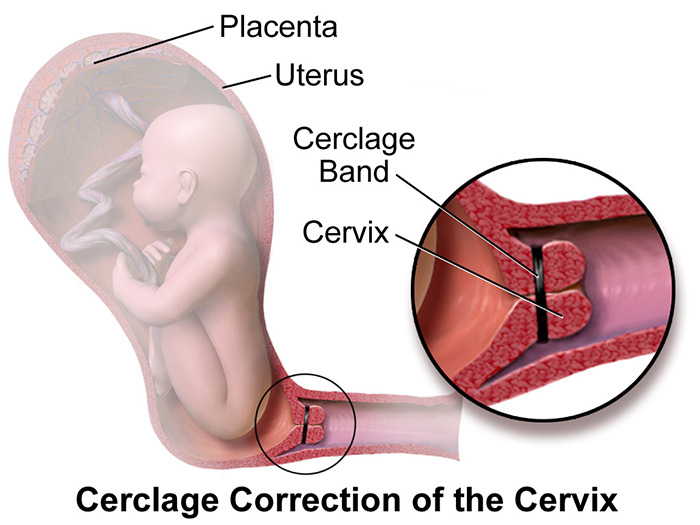
Cervical cerclage refers to the surgical placement of a tape or suture around the cervix with a goal to prevent dilation and resultant premature birth. Medical providers should base their decision to use this treatment in mid-pregnancy after evaluating these 3 factors: (a) History of premature births; (b) Shortened length of the cervix detected with a transvaginal ultrasound test; and (c) Short or dilated cervix detected during a physical examination.
In simplistic terms, cervical cerclage can be described as a physical closure of an incompetent cervix. Meta analyses of randomized clinical trials have shown a reduction of 20% in the rate of preterm births with cervical cerclage compared to no treatment. Research until now has been limited with inconclusive results regarding the superiority of cervical cerclage in comparison to progesterone therapy or cervical pessary.
Treatment of Maternal Infection
Intra-uterine inflammation and infection are known to play a role in the occurrence of spontaneous preterm labor, especially in premature births before 32 weeks of pregnancy or when the pregnancy is complicated by PROM. The vagina is the primary location of maternal infections, and a vigorous inflammatory response to the infection may result in premature birth.
Sexually transmitted infections as well as common vaginal bacteria, such as group B streptococcus and other pathogens may have a role to play in the causal pathway to premature birth. There is some scientific evidence to show that treatment of these infections earlier in the pregnancy can help prevent premature birth. For instance, researchers have shown that administration of an antibiotic medication (such as clindamycin) in expectant mothers with abnormal vaginal microorganisms prior to 22 weeks of pregnancy may lower the risk of premature birth.
With the most common maternal infection, Group B streptococcus, there is research evidence to suggest that premature birth is associated with GBS colonization in expectant mothers, particularly when there are signs of ascending infection (bacteriuria or bacteria in the urine). Although clinical trials have demonstrated the efficacy of intrapartum antibiotic prophylaxis (IAP) in the prevention of neonatal group B strep infections, prevention strategies continue to be inconsistently or inadequately implemented, resulting in continued high rates of group B streptococcal infections in premature babies.
Magnesium Sulfate for Premature Fetal Neuroprotection
In the US, magnesium sulfate is the most widely used drug of choice for the treatment of preterm labor. This compound should only be administered intravenously with an initial infusion of 4g to 6g over 15 to 30 minutes, followed by maintenance doses of 2g to 3g per hour. For expectant mothers who are at a risk of early premature birth (earlier than 32 to 34 weeks of pregnancy), the use of magnesium sulfate for the baby’s neuroprotection may be recommended.

While the drug is being administered, the care team should monitor the mother for clinical signs of magnesium toxicity. The care team should record her pulse rate, blood pressure, rate of respiration, and deep tendon reflexes (such as, patellar – the tendon connecting the kneecap to the shinbone) at least every four hours.
The medical team of doctors and nurses should also closely monitor the health of the baby with electronic fetal monitoring equipment. If there are signs of fetal distress, bradycardia, uterine hyperstimulation or placental abruption the team must act quickly including being prepared to perform an emergency c-section.
Corticosteroids to Support Fetal Lung Maturity
When the medical provider suspects the birth of a premature baby, one of the key steps they can take is to administer corticosteroids (such as betamethasone) to the expectant mother prior to delivery. According to ACOG, during 24 to 34 weeks of pregnancy, a single dose of betamethasone should be administered if the medical team suspects preterm labor to occur within a week.
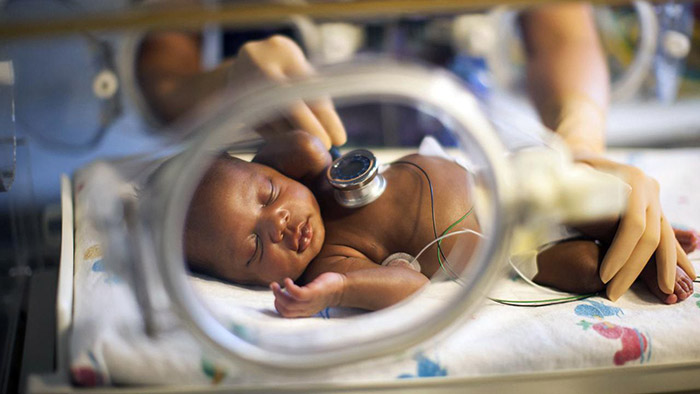
Antenatal (before birth) steroid treatment is known to accelerate and promote the baby’s lung maturity, reduce their risk of intraventricular hemorrhage, lower the inflammation rates, and shorten the premature baby’s stay in the hospital. The risk of the baby developing respiratory distress syndrome, brain bleeds which could lead to cerebral palsy, white matter damage and other prenatal and postnatal complications is lowered when lungs develop faster with antenatal corticosteroids.
Judicious Use of Tocolytic Drugs to Inhibit Preterm Uterine Contractions
An obstetrical procedure called tocolysis involves the use of medications to delay the birth when an expectant mother presents with preterm contractions. Tocolytic therapy should only be administered for the minimal time possible (up to 48 hours or less in most cases) and promptly withdrawn once the contractions have stopped. After 34 weeks of pregnancy, extending the pregnancy with medications is generally not indicated, considering the risks involved.
Medical providers should individualize the therapy after carefully determining the most effective tocolytic agent for a patient with minimal side effects. Tocolytic drugs used in clinical practice include Betamimetics, Nitric Oxide (NO) donors, Oxytocin receptor antagonists, and Calcium antagonists.
Betamimetics are the most-studied tocolytic medications that inhibit uterine contractions by increasing the intra-cellular concentration of muscle relaxing agents. Pertaining to this, these drugs also have the highest rates of side effects among all tocolytic drugs. Oxytocin antagonists, on the other hand, may have relatively lower maternal and fetal side effects, and could be as effective as betamimetics. Calcium antagonists are the most preferred tocolytic drugs as per the clinical guidelines of the Royal College of Surgeons (UK) because of their efficacy and tolerance.
Is Your Child’s Premature Birth Related Complication the Result of Medical Malpractice?
Parents whose children suffer a birth injury from premature birth related complications deserve answers as to how their child developed this condition and whether the complications resulting from it were preventable. Were there signs during the pregnancy, labor, and delivery process that premature birth or its related complication was occurring, but accurate diagnosis, correct treatment, or an emergency c-section was either delayed or not performed at all leading to birth injuries? Was a neonatal resuscitation team not called to delivery in a timely manner to address breathing difficulties? Were signs of a fetal distress due to preterm birth not recognized and responded to in a timely manner? Did the baby qualify for hypothermia therapy, but the doctors and nurses failed to perform the appropriate analysis or ignored the results of the analysis?
Our dedicated birth injury lawyers want to help you find those answers and obtain that coveted financial reward necessary to provide care and therapy that can help improve the quality of your child’s life. A lawsuit settlement can improve the quality of life for your child.
If your child has been diagnosed with a premature birth injury (including Hypoxic-Ischemic Encephalopathy (HIE) or cerebral palsy), and you suspect this may have been caused in part by medical mistakes, Miller Weisbrod Olesky will thoroughly investigate the facts and hold responsible medical providers and hospitals accountable by pursuing medical malpractice claims against them. The compensation our clients receive helps them pay for their child’s current and future medical treatment, therapy and attendant care to help the child adjust to living with a permanent disability, and to be able to pay for cutting-edge devices that increase a child’s quality of life.
Sometimes families are hesitant to reach out to a medical malpractice lawyer or law firm. It’s also not uncommon for parents to feel overwhelmed by their circumstances and worried that they will not be able to help out in a lawsuit involving their child’s birth injury.
Registered Nurses and Nurse-Attorneys Are a Vital Part of Our Birth Injury Team…and Yours

Most national birth injury law firms will employ one or two nurses to assist the review of cases and medical research. But Miller Weisbrod Olesky offers an unmatched number of nurses and nurse-attorney employees support to both the birth injury attorneys and our clients.
Our team of registered nursing staff and nurse-attorneys bring a deep level of medical and personal insight to every client’s case. Our nursing team includes both an experienced labor and delivery nurse as well as an ICU nurse. Working closely with the rest of the team, they investigate the reasons behind a birth injury and how medical professionals breached their standard of care.
Meet our Legal Nursing Team
Linda Chalk

As a registered nurse, Linda practiced ICU nursing for 44 years while caring for a wide range of patient conditions. She has worked closely with founding partner Les Weisbrod for over 30 years, investigating and pursuing birth injury cases.
Along with DJ Weisbrod, Linda heads up the firm’s birth injury intake, screening, and medical literature research team. She personally screens all potential cases to ensure that medical issues have been addressed before we file lawsuits on behalf of birth-injured children and their families.
DJ Weisbrod

Before joining Miller Weisbrod, DJ practiced as a surgical nurse in various hospital and operative settings. She has been with the firm over 30 years.
DJ directs Miller Weisbrod’s birth injury intake and medical screening team. She has also served as firm founder Les Weisbrod’s trial nurse for all cases involving medical negligence and birth injury.
Linda Cuaderes

Linda Cuaderes is both a registered nurse and a licensed lawyer. Linda works exclusively in Miller Weisbrod’s Birth Injury and Medical Malpractice section. Linda acts as the firm’s patient advocate and liaison with our young clients and their parents.
Linda combines her legal and nursing experience along with her exceptional organizational talent and attention to detail to make sure each child we represent is provided the highest level of medical care and attendant care during the pendency of their case. Linda communicates with our parent clients regularly to monitor their birth injured child’s treatment, provide guidance as to additional care and therapies and when necessary assist them in obtaining specialized medical providers.
Linda was raised in Bartlesville, Oklahoma and completed her Bachelor of Science in Nursing with Honors at the University of Oklahoma. She started as an Oncology Nurse at Presbyterian Hospital in Oklahoma City, quickly becoming the Assistant Head Nurse of the Outpatient Endoscopy Unit. Linda then entered the University of Oklahoma College of Law.
Following graduation, Linda joined Les Weisbrod in the Medical Malpractice Section. After taking time off to raise her three lovely children, Linda returned to Miller Weisbrod and her passion of holding healthcare providers accountable for preventable errors. Linda is active in the American Association for Justice, Texas Trial Lawyers Association, Dallas Trial Lawyers Association, and the Texas Bar Association. Linda is an active member of the Birth Trauma Litigation Group and Medical Negligence Section of the American Association for Justice.
She is admitted to practice before the Texas Supreme Court and routinely works on cases pending throughout the United States. Linda has worked with child victims of birth injury, their parents and other victims of medical malpractice in Texas, New Mexico, Oklahoma, Arkansas, Louisiana, Iowa, Ohio, New York, Alabama, Georgia, Arizona, Utah and Missouri.
Education
- University of Oklahoma - School of Law, 1990, J.D. - Norman, Oklahoma
- University of Oklahoma - School of Nursing, 1985 - Norman, Oklahoma
Areas of Practice
- Birth Injury/Birth Trauma
- Medical Malpractice
Associations & Memberships
- Texas Bar Association
- American Association of Justice
- Texas Trial Lawyers Association
- Dallas Trial Lawyers Association
Kristin Jones

Kristin combines her medical and legal training to provide invaluable, passionate service to parents struggling to care for their birth-injured children.
Families often have questions as they go through the birth injury lawsuit process. Kristin diligently identifies and investigates all medical issues so the birth injury attorneys at Miller Weisbrod can answer those questions Kristin ensures that our birth injured children’s medical records are thoroughly reviewed and organized. Miller Weisbrod’s birth trauma litigation attorneys and medical experts retained by the firm need her services while pursuing justice for our clients.
Kelly Kunkel

Kelly Kunkel was born and raised in Dallas, Texas. She has 15 years’ experience in hospital based High Risk Obstetrics and Labor and Delivery bedside nursing care. Kelly graduated with an Associate’s Degree in Nursing from El Centro College in December of 1990 and received her Bachelor’s Degree in Nursing from West Texas A & M University in 2008; graduating with honors.
In addition, Kelly has over 25 years’ experience in medical malpractice case management and litigation and has worked with David Olesky for over 22 years. After many years of assisting in defending healthcare providers and hospital systems in medical malpractice cases involving complex litigation matters related to birth injury, catastrophic injury and death, Kelly has proudly joined David Olesky in the national birth injury and medical negligence practice at Miller Weisbrod Olesky.
Why Should You Talk with the Knowledgeable Attorneys at Miller Weisbrod Olesky?
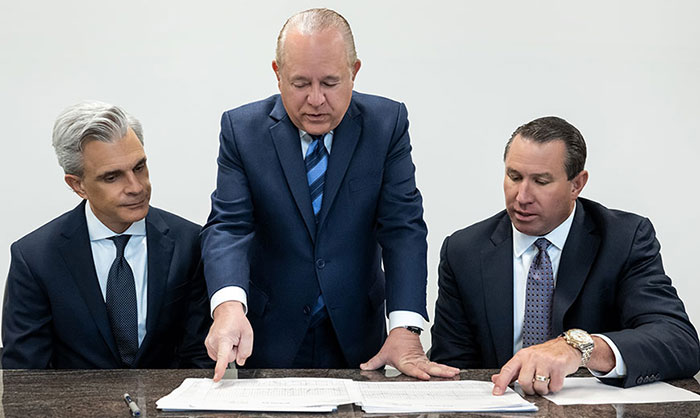
The only way to find out if you have a birth injury case is to talk to an attorney who understands birth injuries leading to a delay or failure in developmental milestones including birth injuries that cause cerebral palsy. It’s not uncommon that a premature birth related complication can be a preventable birth injury, but it takes a detailed expert review by a birth injury lawyer of the facts and circumstances of your child’s birth to determine the birth injury was the result of medical malpractice.
At Miller Weisbrod Olesky, a team of committed lawyers, nurses and paraprofessionals uses our detailed medical negligence case review process to assess your potential birth injury case. We start by learning more about you and your child and the status of meeting/missing developmental milestones. Then we gather medical records to determine what happened before, during, and after your delivery. We call in skilled medical experts who review your records and let us know if they think medical errors could have caused your child’s injuries.
If we feel medical negligence caused or contributed to your child’s injuries, we meet with you to discuss how you can receive compensation from the medical professionals who made the errors. Our birth injury attorneys have recovered millions of dollars in settlements for families of babies that have suffered a birth injury.
At no point in our legal intake process will we ask you to pay anything. The medical review of your case and the consultation are free. We only receive payment when you do.
Contact Our National Birth Injury Lawyers
Our Birth Injury Attorneys
Les Weisbrod

Les Weisbrod has been on the cutting edge of the national birth injury litigation scene for almost 40 years.
As a national birth injury attorney, Les has settled over 204 medical negligence cases for more than $1,000,000. He also obtained settlements in 75 birth injury cases for over $1,000,000 each.
His $31 million verdict against Baylor University Medical Center in Dallas was one of the top 100 verdicts in the United States that given year.
Les is recognized nationally and internationally as one of the top plaintiff’s medical malpractice trial lawyers in the United States. But the recoveries for the clients and the differences made in the lives of the children and families Les has represented tell only part of the story.
Les has worked with his law partner Clay Miller for years to build a one-of-a-kind law firm.
Miller Weisbrod Olesky provides unique and unparalleled services to families of birth-injured and brain-injured children from the moment the firm decides to take the case.
The registered nurses and registered nurse-attorneys on staff are valuable team members who assist Miller Weisbrod birth-injury clients. Les has designed a system where each birth injured child is assigned a nurse-attorney liaison to guide them through the process of medical treatment/evaluation, therapies, home assistance, and quality of life improvement.
Miller Weisbrod’s unmatched service allows families to better cope with the immediate challenges facing our young clients.
Birth-injured children and their families are Les and Miller Weisbrod’s priority.
Les and the attorneys at Miller Weisbrod fight for the justice their clients are entitled to under our nation’s system of justice.
This fighting spirit has taken Les across the United States to represent clients in birth injury and medical negligence cases. In fact, he has personally handled cases not only in Texas but also in Arkansas, Arizona, Colorado, Oklahoma, Louisiana, Utah, Iowa, Ohio, Oregon, Montana, Alabama, Georgia, Florida, and New York.
Les and Miller Weisbrod continue to expand their reach of helping brain-injured children to new states each year as we strive to bring a sense of justice to each affected family. And Les is not the only one who notices he fights for his clients.
Michael Rustad, a Professor of Law at Suffolk University Law School in Boston who has done extensive research on punitive damage awards, says,
“Les Weisbrod has obtained more medical malpractice punitive damage jury verdicts for his clients than any other attorney in the United States.”
Also, a well-known defense medical malpractice attorney dubbed Les Weisbrod the “pitbull” of the Texas medical malpractice bar in a media profile of Les published by a major newspaper.
Les shares his experience and knowledge to improve the representation of all birth-injured children and their families.
In the early 1990s, Les recognized that a more focused effort needed to be made to educate attorneys who handle birth injury cases. As a result, Les was the founding Co-Chair of the American Association for Justice (AAJ) Birth Trauma Litigation Group in 1991. He also was a founding Co-Chair of AAJ’s Medical Negligence Litigation Group in 1999 and served as Chair of AAJ’s Professional Negligence Section in 1996.
Combined, these groups have put on more than a hundred continuing education seminars across the United States. helping to educate other attorneys by bringing in world-renowned experts in the fields of:
- labor and delivery
- neonatal care
- the care and treatment of birth-injured children, including those suffering from cerebral palsy and hypoxic-ischemic encephalopathy (HIE)
Education and professional experiences back up his dedication to helping children and families harmed by medical malpractice.
Les received his B.A. magna cum laude in 1975 from Claremont Men’s College and his J.D. in 1978 from Southern Methodist University Law School.
He is Board Certified by the Texas Board of Legal Specialization in Personal Injury Trial Law and Civil Trial Law.
Les was a past president of the Dallas Trial Lawyers Association in 1993. He has been a member of the Texas Trial Lawyers Association Board of Directors since 1990.
His work with the American Association for Justice (AAJ) (formerly ATLA) includes serving as President, President-Elect, Vice President, Secretary, Treasurer, and Parliamentarian. Mr. Weisbrod has also served on the AAJ Board of Governors since 1998 and the 17-member Executive Committee of AAJ since 2001. In 1990, he was chosen as a Rising Star of the ATLA and presented a paper entitled “Dirt and Greed: A New Look at Medical Malpractice Cases.”
Les has written and lectured extensively on birth injury litigation, medical malpractice, and medical product topics.
Les is a contributing author to the 1996 text Operative Obstetrics published by Williams & Wilkins. He also co-authored the “Drugs & Medical Devices” chapter in AAJ’s Litigating Tort Cases.
He also has lectured to lawyer groups across the U.S., Canada, England, and Australia.
Education
- Southern Methodist University - School of Law, J.D. - Dallas, Texas, 1978
- Claremont Men's College - B.A. - Claremont, California, 1975
Areas of Practice
- Medical Malpractice
- Birth Injury/Birth Trauma
- Products Liability
- Personal Injury
Associations & Memberships
- State Bar of Texas
- National Association Of Distinguished Counsel
- Million Dollar Advocates Forum
- Multi-Million Dollar Advocates Forum
- American Association for Justice
- Texas Trial Lawyers Association
- Dallas Trial Lawyers Association
- Pan-European Organization of Personal Injury Lawyers
- American Society of Law and Medicine
- Consumer Attorneys of California
- Arkansas Trial Lawyers Association
- Louisiana Trial Lawyers Association
- Dallas and American Bar Associations
- ABOTA (American Board of Trial Advocates)
Clay Miller

Clay is Board Certified in Personal Injury Trial Law by the Texas Board of Legal Specialization. Clay has practiced solely in the field of catastrophic injury and wrongful death since graduating from law school. His practice has been limited to the representation of victims. Over the past twenty-four years, Clay has successfully settled or tried to verdict cases in the areas of vehicular negligence, medical malpractice, construction site accidents, workplace injury, premises liability, and commercial trucking and a nationwide business loss case (suits filed in a dozen different states) involving defective truck engines sold to trucking companies.
Clay represented dozens of trucking companies in lost profit and diminished value claims against Caterpillar in 2010 through 2012. These cases were filed in over a dozen states with the bellwether trial set in Federal Court in Davenport, Iowa. After intense litigation and trial preparation, a global confidential settlement was reached for all the clients.
Clay's most recent 2017 victories are a $30,800,000 jury verdict in Tennessee arising from fraud claims in the sale of heavy-duty truck engines and a $26,500,000 jury verdict in a construction accident, obtained within 60 days of each other.
Clay was raised in Lewisville, Texas and completed his undergraduate degree in Finance at
Texas A & M University. Following graduation from Southern Methodist University School of law, Clay worked for two Dallas firms representing victims. In 1998, Clay began his own practice before forming his current partnership. In addition to his law practice, Clay has lectured at seminars and published in the areas of construction accidents, jury selection techniques, medical negligence, trucking accidents and settlement tactics.
He is active in local and statewide trial lawyers' associations including serving as the Chair of the Advocates for the Texas Trial Lawyers' Association in 2002 and remains on the Board of Directors. Clay served as President of the Dallas Trial Lawyers Association from 2008-2009. He has also been a member of the American Board of Trial Advocates (ABOTA) since 2014.
Education
- Southern Methodist University School of Law - Dallas, Texas
- Texas A&M University - Finance - College Station, Texas
Areas of Practice
Associations & Memberships
- State Bar of Texas
- State Bar of New Mexico
- State Bar of Colorado
- American Board of Trial Advocates (ABOTA)
- Texas Trial Lawyers Association
- Dallas Trial Lawyers’ Association
- American Association of Justice
David Olesky

David Olesky is Vice Chair of the Health Care Professional Liability practice. David is a trial lawyer focusing his practice on complex litigation matters that involve defending and protecting clients in all types of cases related to catastrophic injuries or death, but with a special focus on birth injury cases. David regularly advises his health care clients on the issues and challenges that they face on a daily basis. Clients repeatedly look to him for guidance to handle such high stakes cases and matters in Texas and jurisdictions outside of Texas.
David has earned the trust and reliance of clients he has worked with by consistently getting the results that matter most to them, whether that is a win at trial or a favorable outcome through alternative dispute resolution outside the courthouse. Through his representation, David demonstrates a true loyalty and hardworking commitment to the clients that he serves.
David believes the foundation of any client relationship is to act as a trusted advisor instead of simply as a litigator. Clients value his earnest representation of their business interests, accompanied by a devotion to understanding their businesses, prompt attention to their immediate needs and the challenges they face in their individual roles.
Education
- Southern Methodist University Dedman School of Law, J.D., 1992 - Dallas, Texas
- University of Texas, B.B.A, 1989 - Austin, Texas
Areas of Practice
Associations & Memberships
- American Bar Association
- Dallas Bar Association
- Dallas Bar Foundation Fellow
- Texas Bar Association
Alexandra V. Boone

Alexandra Boone is a partner in Miller Weisbrod. She concentrates her legal practice in the area of birth injury, medical malpractice and mass tort products liability. Alex currently works directly with firm partner Les Weisbrod in managing the birth injury docket and working with the firm’s highly qualified expert witnesses in the review of potential cases. Alex also litigates her own docket of medical negligence cases.
Over the course of her 17 years with the firm, Alex has focused on the administration and prosecution of mass tort litigation, originally focusing on occupational toxins, but more recently in the area of pharmaceuticals and medical devices. In the past, she has actively pursed cases involving hormone therapy, Vioxx, Fosamax, and Reglan. Alex was also instrumental in our firm successfully resolving thousands of cases transvaginal mesh, hip prosthetics, and the blood thinner Xarelto. She is actively prosecuting over 1,000 cases.
In addition to being a member of the Texas bar, she is also licensed in Oklahoma and is a member of the American Association of Justice, Texas Trial Lawyers Association, Oklahoma Association of Justice and the Dallas Trial Lawyers Association.
Education
- Baylor University - School of Law, 1996, J.D. - Waco, Texas
Areas of Practice
- Products Liability
- Mass Tort
Associations & Memberships
- State Bar of Texas
- American Association of Justice
- Texas Trial Lawyers Association
- Oklahoma Association of Justice
- Dallas Trial Lawyers Association
Pro Bono Activities
- East Texas Legal Services/Nix Law Firm Pro Bono Project, 1996 - 1997
Robert Wolf

Robert E. Wolf was born in Dallas, Texas and graduated Magna Cum Laude as a proud horned frog from Texas Christian University in 1997, with Bachelor of Science degree in Political Science and was inducted into Phi Beta Kappa and Mortar Board. He obtained his law degree from Southern Methodist University in 2000 while serving as an Articles Editor for the International Law Review and winning awards at Mock Trial and Appellate competitions.
Robert has been named a Thomson Reuters | Texas Super Lawyers Rising Star (less than 2.5% of attorneys in Texas receive this distinction) in 2011, 2012, 2013, 2014, and 2015. Further, Robert was recognized as a National Trial Lawyers Top 40 Under 40 attorney for Texas in 2012 (no more than 40 attorneys in Texas are eligible for this award annually).
Robert brought his passion for and over 14 years of experience of representing seriously injured individuals and their families to Miller Weisbrod in January 2015, and has concentrated his legal practice in the area of medical malpractice, products liability, and pharmaceutical/mass tort litigation. He is a member of the State Bar of Texas, American Association for Justice, Texas Trial Lawyers Association, and Dallas Trial Lawyers Association.
In addition to many successful jury verdicts and settlements across Texas, Oklahoma, Iowa, Wisconsin, and Idaho, Robert’s role as an attorney representing victims and their families has led to numerous changes to key safety practices and policies and procedures at corporations and medical facilities.
Robert and his wife Suzy also get plenty of exercise trying to keep up with their precious and very active daughter.
Education
- Southern Methodist University - Dedman School of Law, J.D. - 2000 - Dallas, Texas
- Texas Christian University - B.S. Political Science - 1997 - Fort Worth, Texas
Areas of Practice
- Medical Malpractice
- Personal Injury
- Products Liability
Associations & Memberships
- State Bar of Texas
- American Association of Justice
- Texas Trial Lawyers Association
- Dallas Trial Lawyers Association
Carrie Vine

Carrie Lynn Vine has over 15 years of experience in medical malpractice litigation, with a particular focus in representing children and families who have suffered birth injuries as a result of the negligence of either doctors, nurses or hospitals.
She is a passionate advocate for her clients and has handled hundreds of birth injury and birth trauma cases throughout the United States. As part of Carrie’s national birth injury legal practice, she has handled cases in Texas, Arkansas, California, Nevada, Kentucky, Georgia, Illinois, Wisconsin, Ohio, Pennsylvania, North Carolina, South Carolina, Florida, and North Dakota. She is determined to seek justice and works to obtain fair compensation for the children and families she represents.
Carrie earned her law degree from Northern Illinois University where she tutored other law students. Prior to law school, she received her undergraduate degree from the University of Notre Dame in Biomedical and Biological Science, and earned both a Master’s Degree and a Ph.D. from The Pennsylvania State University in Anthropological Genetics. She then conducted post-doctoral research at the University of Michigan Medical School before deciding to attend law school. She applies an academic mindset and love of science and medicine to mastering the medical principles and literature relevant to the cases she pursues.
Carrie is an active member of the American Association of Justice as well as the Birth Trauma Litigation Group (BLTG).
Education
- Northern Illinois University:
Law School
- University of Notre Dame:
Biomedical Science
- Pennsylvania State University:
Anthropological Genetics
Areas of Practice
- Birth Injury/Birth Trauma
- Medical Malpractice
Associations & Memberships
- American Association of Justice:
Member
- Birth Trauma Litigation Group:
Member
Larry Lassiter

Lawrence R. Lassiter is an AV-rated attorney with more than twenty years of experience in appellate and trial advocacy. He has been consulted by attorneys across the country to conduct research, evaluate cases, prepare appellate and trial briefs, and formulate litigation strategy. He has prepared hundreds of appellate briefs in federal and state appellate courts, including the highest courts of Texas, West Virginia, Georgia, Oklahoma, Ohio, Nebraska and Tennessee, and he is member of the Bar of the United States Supreme Court. Larry has a national appellate and legal briefing practice. Larry has filed extensive briefs and/or argued before either state or federal courts in 30 out of 50 states in his career.
Larry assists the Birth Injury team in all aspects of legal briefing. Unlike many other birth injury firms across the United States, Miller Weisbrod has an attorney dedicated to handling legal briefing on behalf of our clients across the country. Larry has handled extensive briefing in birth injury and other medical malpractice cases in Texas, New Mexico, Arkansas, Oklahoma, Iowa, Ohio, Alabama, Georgia, New York, Utah, Arizona, Louisiana and West Virginia.
Since joining Miller Weisbrod in 2010, Larry has won a number of important victories vindicating the rights of our clients in both state and federal appellate courts, including Vitacost.com, Inc. v. McCants, 210 So.3d 761 (Fla. Ct. App. 2017); TTHR Ltd. Partnership v. Moreno, 401 S.W.3d 41 (Tex. 2013); In re E.B., 729 S.E.2d 271 (W. Va. 2012); Mid-Continent Cas. Co. v. Davis, 683 F.3d 651 (5th Cir. 2012); Rouhani v. Morgan, 2017 WL 3526719 (Tex. App. – Houston [1st Dist.] 2017, no pet.); Mid-Continent Cas. Co. v. Andregg Contracting, Inc., 391 S.W.3d 573 (Tex. App. – Dallas 2012).
He was as a judicial clerk for the Honorable Harlington Wood Jr., Circuit Judge, United States Court of Appeals for the Seventh Circuit. Larry was a University of Iowa Presidential Scholar and served as Editor in Chief of the Iowa Law Review.
Larry is an active member of the American Association for Justice. He is a member of AAJ’s Birth Injury Litigation Group and Medical Negligence Sections.
Education
- University of Iowa - Political Science & History - B.A. - Iowa City, Iowa
- University of Iowa - School of Law - J.D. - Iowa City, Iowa
Areas of Practice
- Appellate Advocacy
- Medical Malpractice
- Pharmaceuticals & Medical Devices
- Products Liability
- Personal Injury
Associations & Memberships
- State Bar of Texas
- American Association of Justice
- Texas Trial Lawyers Association
- Dallas Trial Lawyers Association
Laurie Pierce
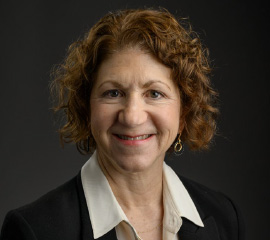
Laurie draws upon extensive experience in state and federal courts with a focus on complex claims involving medical malpractice cases. After many years of defending health care providers and hospital systems in medical malpractice cases, Laurie joined David Olesky in the national birth injury and medical negligence practice at Miller Weisbrod Olesky.
Laurie’s focus is to understand not only the facts and circumstances of the matter at hand, but to understand the specific needs and goals of the client and their unique business considerations. Her extensive background in commercial litigation provides a foundation that enhances her health care litigation practice. She works with clients that require more than a strong trial lawyer; they expect an attorney who understands the relationship between law and their specific business and who will work tirelessly to protect their rights, interests and bottom line.
Education
- Southern Methodist University:
Dedman School of Law - 1992
- Order of the Coif:
Journal of Air Law and Commerce, J.D. - 1992
- Miami University-Oxford, Ohio
B.S. Education - 1982
Areas of Practice
- Birth Injury/Birth Trauma
- Health Care Industry
- Health Care Litigation
- Litigation and Dispute Resolution
- Medical Malpractice
Associations & Memberships
- American Association for Justice
- American Bar Association
- Dallas Bar Association
- Dallas Bar Foundation Fellow
- Texas Bar Association
Distinctions
- Admitted to Pro Bono College of State Bar of Texas in 2019 for outstanding delivery of legal services to low-income Texans
Court Admissions
- United States Supreme Court
- U.S. District Court, Eastern District of Texas
- U.S. District Court, Northern District of Texas
- U.S. District Court, Southern District of Texas
- U.S. District Court, Western District of Texas
Linda Cuaderes

Linda Cuaderes is both a registered nurse and a licensed lawyer. Linda works exclusively in Miller Weisbrod’s Birth Injury and Medical Malpractice section. Linda acts as the firm’s patient advocate and liaison with our young clients and their parents.
Linda combines her legal and nursing experience along with her exceptional organizational talent and attention to detail to make sure each child we represent is provided the highest level of medical care and attendant care during the pendency of their case. Linda communicates with our parent clients regularly to monitor their birth injured child’s treatment, provide guidance as to additional care and therapies and when necessary assist them in obtaining specialized medical providers.
Linda was raised in Bartlesville, Oklahoma and completed her Bachelor of Science in Nursing with Honors at the University of Oklahoma. She started as an Oncology Nurse at Presbyterian Hospital in Oklahoma City, quickly becoming the Assistant Head Nurse of the Outpatient Endoscopy Unit. Linda then entered the University of Oklahoma College of Law.
Following graduation, Linda joined Les Weisbrod in the Medical Malpractice Section. After taking time off to raise her three lovely children, Linda returned to Miller Weisbrod and her passion of holding healthcare providers accountable for preventable errors. Linda is active in the American Association for Justice, Texas Trial Lawyers Association, Dallas Trial Lawyers Association, and the Texas Bar Association. Linda is an active member of the Birth Trauma Litigation Group and Medical Negligence Section of the American Association for Justice.
She is admitted to practice before the Texas Supreme Court and routinely works on cases pending throughout the United States. Linda has worked with child victims of birth injury, their parents and other victims of medical malpractice in Texas, New Mexico, Oklahoma, Arkansas, Louisiana, Iowa, Ohio, New York, Alabama, Georgia, Arizona, Utah and Missouri.
Education
- University of Oklahoma - School of Law, 1990, J.D. - Norman, Oklahoma
- University of Oklahoma - School of Nursing, 1985 - Norman, Oklahoma
Areas of Practice
- Medical Malpractice
- Birth Injury/Birth Trauma
Associations & Memberships
- Texas Bar Association
- American Association of Justice
- Texas Trial Lawyers Association
- Dallas Trial Lawyers Association
Kristin Jones

Kristin combines her medical and legal training to provide invaluable, passionate service to parents struggling to care for their birth-injured children. Families often have questions as they go through the birth injury lawsuit process. Kristin diligently identifies and investigates all medical issues so the birth injury attorneys at Miller Weisbrod can answer those questions. Kristin ensures that our birth injured children’s medical records are thoroughly reviewed and organized. Miller Weisbrod’s birth trauma litigation attorneys and medical experts retained by the firm need her services while pursuing justice for our clients.
Education
- SMU Dedman School of Law - Dallas, Texas
- University of Texas at Arlington - Arlington, Texas
Areas of Practice
- Medical Malpractice
- Birth Injury/Birth Trauma
Associations & Memberships
- State Bar of Texas
- American Association of Justice
- Texas Trial Lawyers Association
Matt Adair

Matt Adair is an attorney specializing in medical malpractice, products liability, and pharmaceutical litigation. He received his bachelor’s degree in Philosophy from the University of Notre Dame. During his time there, he studied abroad at the New College at Oxford University in Oxford, England.
Matt is a member of the State Bar of Texas, American Association for Justice, Texas Trial Lawyers Association, and Dallas Trial Lawyers Association.
Education
- University of Notre Dame - Philosophy, B.A. 2012 - Notre Dame, Indiana
- Baylor University - School of Law J.D. 2015 - Waco, Texas
Areas of Practice
- Medical Malpractice
- Products Liability
- Pharmaceutical Litigation
Associations & Memberships
- State Bar of Texas
- American Association of Justice
- Texas Trial Lawyers Association
- Dallas Trial Lawyers Association
Garrett Stanford

Garrett Stanford was born in Dallas, Texas and graduated from Southern Methodist University in 2017 with a B.A. in Political Science. After graduation, he attended Baylor University School of Law. During his time at Baylor, he was a member of the Order of the Barristers and he won the Judge W.C. Davis Endowed Criminal Practice Professional Track Award. He obtained his law degree and license to practice law in 2020.
Garrett joined Miller Weisbrod in August 2021. His legal practice is concentrated in the area of birth injury and medical malpractice. Garret is actively involved in handling birth injury and medical malpractice cases in Texas, Ohio, Utah, Arkansas and Oklahoma.
Education
- Southern Methodist University - Political Science, B.S. - Dallas, Texas
- University of Baylor - School of Law, J.D. - Waco, Texas
Areas of Practice
- Medical Malpractice
- Birth Injury/Birth Trauma
Associations & Memberships
- State Bar of Texas
